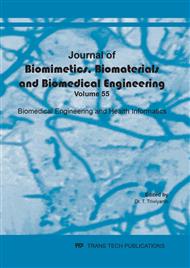[1]
Shaojun Jiang and Yilin He, A low power circuit for medical drip infusion monitoring system,, IEEE International Conference on Smart Internet of Things (SmartIoT), Pp. 342-345, (2020).
DOI: 10.1109/smartiot49966.2020.00062
Google Scholar
[2]
Cyril Bresch, David Hély, Stéphanie Chollet, and Roman Lysecky, SecPump: A Connected Open-Source Infusion Pump for Security Research Purposes,, IEEE Embedded Systems Letters, Vol. 13, Pp. 21–24, (2021).
DOI: 10.1109/les.2020.2979595
Google Scholar
[3]
Meo Vincent Caya, Marvin U. Cosindad, Nicanor I. Marcelo Jr., Jose Nicolas M. Santos, and Jumelyn L. Torres, Design and Implementation of an Intravenous Infusion Control and Monitoring System,, IEEE International Conference on Consumer Electronics - Asia (ICCE-Asia), (2019).
DOI: 10.1109/icce-asia46551.2019.8941599
Google Scholar
[4]
Guanglou Zheng, Wencheng Yang, Craig Valli, Rajan Shankaran, Haider Abbas, Guanghe Zhang, Gengfa Fang, Junaid Chaudhry, and Li Qiao, Fingerprint Access Control for Wireless Insulin Pump Systems Using Cancelable Delaunay Triangulations,, IEEE Access, Vol. 7, Pp. 75629– 75641, (2019).
DOI: 10.1109/access.2019.2920850
Google Scholar
[5]
Y. Zhang S.F., Zhang Y., and Ji G.X. Wu, Wireless sensor network-enabled intravenous infusion monitoring,, IET Wireless Sensor Systems, Vol. 1, Iss. 4, Pp. 241–247, (2011).
DOI: 10.1049/iet-wss.2011.0031
Google Scholar
[6]
Agung W. Setiawan, Nurul Yenas, and Deddy Welsan, Design and Realization of Low-Cost Wireless Remote Infusion Monitoring System,, International Seminar on Application for Technology of Information and Communication, Pp. 151-154, (2018).
DOI: 10.1109/isemantic.2018.8549820
Google Scholar
[7]
J. P. Silva, B. A. Rodrigues, J. C. S. Casado, and S. S. R. F. Rosa, Infusion Pump: Bond Graph Mathematical Modeling for Blood Pressure Control,, IEEE Latin America Transactions, Vol. 16, Pp. 1569 – 1573, 20018.
DOI: 10.1109/tla.2018.8444151
Google Scholar
[8]
Mikroelektronika, mikroC PRO for PIC,, Software and Hardware Solutions For Embedded World, (2009).
Google Scholar
[9]
Amelia Klarich, Thomas Z, Noonan Chris Reichlen, St Marie J, Barbara, Laura Cullen, Priyadarshini R. Pennathur, Usability of smart infusion pumps: A heuristic evaluation,, Applied Ergonomics, (2021).
DOI: 10.1016/j.apergo.2021.103584
Google Scholar
[10]
Yonghong Zhang, Xinfeng Shen, Qing Yang, Chengshan Qian, and Guangchi Liu, Infusion Auxiliary Service System Based on Zigbee Wireless Network,, Special Section on Human-Centered Smart Systems and Technologies, Vol. 6, (2018).
DOI: 10.1109/access.2018.2809676
Google Scholar
[11]
Cuilin Bei, Yanli Liu, and Jungai Gu, Medical intelligent infusion monitoring system based on 5G network and FPGA,, Microprocessors and Microsystems, (2020).
DOI: 10.1016/j.micpro.2020.103393
Google Scholar
[12]
Hidekuni Ogawa, Hiromichi Maki, Sosuke Tsukamoto, Yoshiharu Yonezawa, Hikaru Amano, and W. Morton Caldwell, A new drip infusion solution monitoring system with a free-flow detection function,, IEEE Engineering in Medicine and Biology, Pp. 1214-1217, (2010).
DOI: 10.1109/iembs.2010.5626449
Google Scholar
[13]
Taeyang Kim, Jinwook Kim, Student Member, Ieee, And Xiaoning Jiang, Transit Time Difference Flowmeter For Intravenous Flow Rate Measurement Using 1–3 Piezoelectric Composite Transducers,, IEEE Sensors Journal, Vol. 17, No. 17, September 1, (2017).
DOI: 10.1109/jsen.2017.2727340
Google Scholar
[14]
Ramisha Rani K., Shabana N., Tanmayee P., Loganathan S., and Dr. Velmathi G., Smart Drip Infusion Monitoring System for Instant Alert – Through nRF24L01,, IEEE Access, Pp. 452-455, (2017).
DOI: 10.1109/icnets2.2017.8067976
Google Scholar
[15]
George W. Carpenter, Holly G. Myers, Eric A. Sherer, Katie A. Evans, and D. Patrick O'neal, Closed-Loop Intravenous Drug Administration Using Photoplethysmography,, IEEE Journal Of Transisation Engineering In Health And Medicine, Vol. 6, (2018).
DOI: 10.1109/jtehm.2018.2879090
Google Scholar
[16]
Huang Chen Lee and Jheng Sing Lin, An Open-Source Wearable Sensor System for Detecting Extravasation of Intravenous Infusion,, IEEE Transactions on Instrumentation and Measurement, Vol. 70, (2021).
DOI: 10.1109/tim.2020.3025394
Google Scholar
[17]
Richard Crowder, Stepper Motors,, Electric Driver and Electromechanical System (Second Edition), Pp. 209-226, (2020).
DOI: 10.1016/b978-0-08-102884-1.00008-x
Google Scholar
[18]
George W. Carpenter, Holly G. Myers, Eric A. Sherer, Katie A. Evans, and D. Patrick O'neal, Closed-Loop Intravenous Drug Administration Using Photoplethysmography,, IEEE Journal Of Transisation Engineering In Health And Medicine, Vol. 6, (2018).
DOI: 10.1109/jtehm.2018.2879090
Google Scholar
[19]
Huang-Chen Lee and Jheng-Sing Lin, An Open-Source Wearable Sensor System for Detecting Extravasation of Intravenous Infusion,, IEEE Transactions on Instrumentation and Measurement, Vol. 70, (2020).
DOI: 10.1109/tim.2020.3025394
Google Scholar
[20]
Yuan Ping, Bin Hao, Xiali Hei, Yazhou Tu, Xiaojiang Du, and Jie Wu, Feature Fusion And Voiceprint-Based Access Control For Wireless Insulin Pump Systems,, IEEE Access , Vol. 7, (2019).
DOI: 10.1109/access.2019.2937805
Google Scholar
[21]
Nicola Giaquinto, Marco Scarpetta, Maurizio Spadavecchia, and Gregorio Andria, Feature Deep Learning-Based Computer Vision for Real-Time Intravenous Drip Infusion Monitoring,, IEEE Sensors Journal, Vol. 21, Pp. 14148 – 14154, (2021).
DOI: 10.1109/jsen.2020.3039009
Google Scholar
[22]
Karen Kan Wilton and C.Levine, Infusion Pumps,, Anesthesia Equipment (Third Edition), (2021).
Google Scholar
[23]
Mikroelektronika, Creating the First Project in MikroC PRO for ARM,, (2014).
Google Scholar
[24]
M.L. Li and G.W. Zhang, in: The Medical Infusion Alarm System Based on the Smart Phone Platform, edited by M.L. Li and G.W. Zhang, Pp. 1146-1150, (2013).
Google Scholar
[25]
Sensirion, Liquid Flow Meter Kits for SF06 based Liquid Flow Meters,, Operating Guidelines for Liquid Flow Meter Kits, (2019).
Google Scholar


